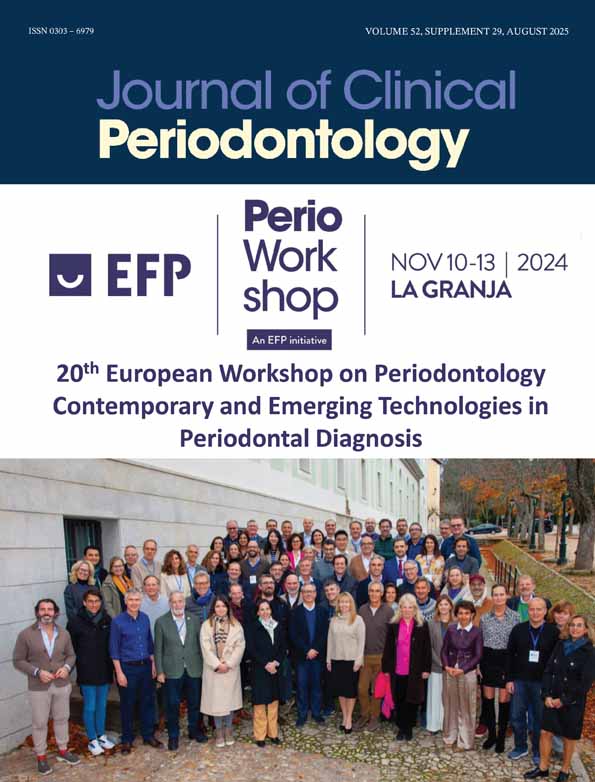Effect of toothpaste on the plaque inhibitory properties of a cetylpyridinium chloride mouth rinse
Abstract
enBackground and aims: Cetylpyridinium chloride (CPC) mouth rinses have moderate plaque inhibitory activity when used alone but rarely have shown adjunctive benefits to tooth brushing with toothpaste. Several explanations for this apparent anomaly can be proferred, including loss of antiseptic activity due to interactions with toothpaste ingredients. The aim of this study was to measure the effect of toothpaste on the plaque inhibitory properties of a CPC mouth rinse using paired rinses of CPC, toothpaste slurry (TP) and water (W).
Methods: The study was a single blind, randomised, seven-treatment, cross over design balanced for residual effects, involving 21 healthy, dentate subjects. The paired rinses were: W-CPC, CPC-W, TP-CPC, CPC-TP, W-TP, TP-W and W-W. Rinsing with solutions or slurries was done for 60 s twice per day. On day 1, subjects were rendered plaque free, suspended tooth cleaning and commenced the allocated rinse regimen. On day 5, plaque was scored by index. A 2½ day wash out of normal oral hygiene was allowed between each regimen.
Results: The order from lowest to highest plaque scores was as follows: W-CPC = CPC-W < CPC-TP < TP-CPC ≤ W-TP < TP-W < W-W. Several differences in pairs of treatments were statistically significant, the most relevant of which were significantly less plaque with W-CPC compared to TP-CPC, TP-W and W-TP, and significantly more plaque with W-W compared to all other regimens except TP-W.
Conclusions: Toothpaste, whilst possessing some plaque inhibitory activity, when used immediately before a CPC mouth rinse adversely affected the plaque inhibitory action of this antiseptic. This in part may explain the reported lack of adjunctive benefits of CPC rinses to normal oral hygiene practices and supports the suggestion, made for chlorhexidine rinses, that their use should follow toothpaste by at least 60 min.
Zusammenfassung
deDie Wirkung von Zahnpasta auf die plaquehemmenden Eigenschaften einer Mundspüllösung mit Cetylpyridinium-Chlorid
Grundlagen und Ziel: Cetylpyridinium-Chlorid (CPC) Mundspüllösung haben, wenn sie alleine verwendet werden, eine moderate plaquehemmende Aktivität. Es wurde jedoch selten gezeigt, dass sie zusätzlich zum Zähneputzen Vorteile haben. Mehrere Erklärungen für diese offensichtliche Anomalie können angeboten werden, einschließlich des Verlusts der antiseptischen Aktivität wegen einer Interaktion mit Inhaltstoffen der Zahnpasta. Ziel dieser Studie war es, die Wirkung der Zahnpasta auf die plaquehemmenden Eigenschaften einer CPC-Mundspüllösung zumessen. Es wurde CPC zusammen mit Zahnpasta-Lösung (TP) oder zusammen mit Wasser (W) verwendet.
Methoden: Die randomisierte, einfach-blinde-Studie hatte ein 7-Behandlungs- Crossover-Design und war ausgeglichen hinsichtlich der Resteffekte. Einundzwanzig gesunde und bezahnte Personen wurden aufgenommen. Die paarweisen Spülungen waren: W-CPC, CPC-W, TP-CPC, CPC-TP, W-TP, TP-W und W-W. Die Spülungen wurden zweimal pro Tag für 60 Sekunden durchgeführt. An Tag-1 wurde bei der Teilnehmern Plaquefreiheit hergestellt, sie enthielten sich der Mundhygiene und begannen die zugewiesenen Spülungen. An Tag-5 wurde die Plaque mittels Index beurteilt. Zwischen den Spülmaßnahmen war eine 2,5-tägige Auswaschperiode mit normaler Mundhygiene erlaubt.
Ergebnisse: Die Reihenfolge vom niedrigsten zum höchsten Plaquewert war W-CPC = CPC-W < CPC-TP < TP-CPC </= W-TP < TP-W < W-W. Mehrere Unterschiede zwischen den Behandlungspaaren waren statistisch signifikant. Der Relevanteste davon war signifikant weniger Plaque mit W-CPC verglichen zu TP-CPC, TP-W und W-TP sowie signifikant mehr Plaque mit W-W verglichen mit allen anderen Spülungen außer TP-W.
Schlussfolgerungen: Zahnpasta beeinflusst, obwohl sie eine gewisse plaquehemmende Aktivität hat, wenn sie unmittelbar vor der CPC-Mundspülung verwendet wird, die plaquehemmende Wirkung dieser antiseptischen Lösung. Dies könnte zum Teil die berichteten nicht vorhandenen Vorteile, wenn die CPC-Mundspülung zusätzlich zur normalen Mundhygiene durchgeführt wird, erklären. Es unterstützt die Annahme, dass Chlorhexidin-Spülungen der Zahnpastaanwendung wenigstens 60 Minuten später folgen sollten.
Résumé
frL'effet d'un dentifrice sur les propriétés inhibitrices de la plaque dentaire d'un bain de bouche au chlorure de cétylpyridinium
Les bains de bouche au chlorure de cétylpyridinium (CPC) ont de faibles activités inhibitrices de la plaque dentaire lorsqu'ils sont utilisés seuls, mais quelquefois révèlent un bénéfice supplémentaire lorsqu'ils sont associés au brossage et à une pâte dentifrice. Différentes explications de cette apparente anomalie peuvent être avancées incluant la perte de l'activité de l'antiseptique dûe aux interactions avec les ingrédients contenus dans le dentifrice. Le but de cette étude a été de mesurer l'effet d'un dentifrice sur les propriétés inhibitrices de la plaque dentaire d'un bain de bouche CPC en utilisant des bain de bouche au CPC, un mélange aqueux d'un dentifrice (TP) et de l'eau (W). Cette étude avait un modèle croisé de sept traitements, randomisé en simple aveugle, balancé pour les effets résiduels comprenant 21 sujets dentés sains. Les paires de rinçage étaient : W-CPC, CPC-W, TP-CPC, CPC-TP, W-TP, TP-W et W-W. Le rinçage avec les solutions ou le mélange aqueux a été effectué durant 60s deux fois par jour. Au jour 1, les sujets se retrouvaient sans plaque dentaire, arrêtaient tout nettoyage dentaire et commençaient le régime préconisé. Au jour 5, la plaque dentaire a été mesurée par indice. Deux jours et demi d'intervalle avec hygiène buccale normale était utilisés entre chaque régime. L'ordre des indices de plaque du plus bas vers le plus haut étaient W-CPC = CPC-W < CPC-TP<TP-CPC </=W-TP<TP-W< W-W. Plusieurs différences dans les paires de traitement étaient statistiquement significatives, la plus importante étant significativement moins de plaque dentaire avec W-CPC comparéà TP-CPC, TP-W et W-TP et significativement plus de plaque dentaire avec W-W comparéà tous les autres régimes excepté TP-W. Le dentifrice possèdant quelques activités inhibitrice sur la plaque dentaire lorsqu'il est utilisé immédiatement avant un rinçage CPC affecte de manière négative l'action inhibitrice de la plaque dentaire de cet antiseptique. Ceci pourrait en partie expliquer le manque de bénéfice supplémentaire des rinçages au CPC avec les pratiques d'hygiène buccale normales.




